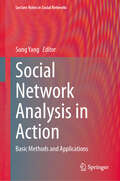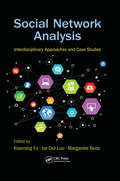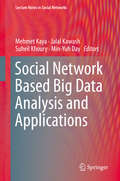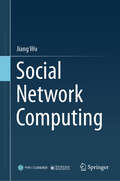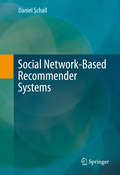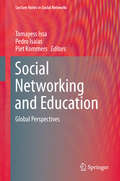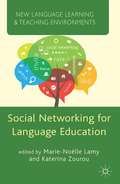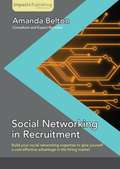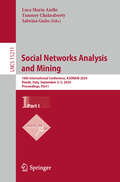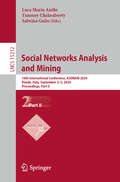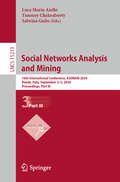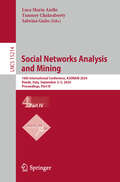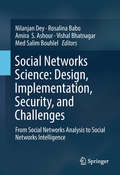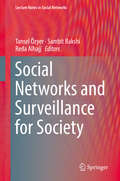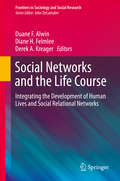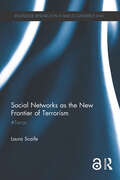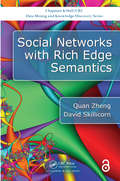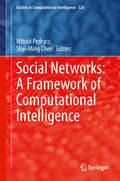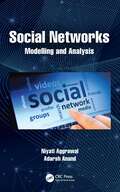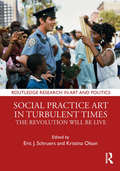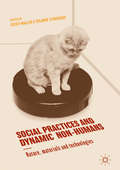- Table View
- List View
Social Network Analysis and Mining Applications in Healthcare and Anomaly Detection (Lecture Notes in Social Networks)
by Mehmet Kaya Min-Yuh Day Sleiman Alhajj Kashfia SailunazThis book is an excellent source of knowledge for readers interested in the latest developments in social network analysis and mining, particularly with applications in healthcare and anomaly detection. It covers topics such as sensitivity to noise in features, enhancing fraud detection in financial systems, measuring the echo-chamber phenomenon, detecting comorbidity, and evaluating the effectiveness of mitigative and preventative actions on viral spread in small communities using agent-based stochastic simulations. Additionally, it discusses predicting behavior, measuring and identifying influence, analyzing the impact of COVID-19 on various social aspects, and using UNet for handling various skin conditions. This book helps readers develop their own perspectives on adapting social network concepts to various applications. It also demonstrates how to use various machine learning techniques for tackling challenges in social network analysis and mining.
Social Network Analysis for Startups: Finding connections on the social web
by Alexander Kouznetsov Maksim TsvetovatDoes your startup rely on social network analysis? This concise guide provides a statistical framework to help you identify social processes hidden among the tons of data now available.Social network analysis (SNA) is a discipline that predates Facebook and Twitter by 30 years. Through expert SNA researchers, you'll learn concepts and techniques for recognizing patterns in social media, political groups, companies, cultural trends, and interpersonal networks. You'll also learn how to use Python and other open source tools—such as NetworkX, NumPy, and Matplotlib—to gather, analyze, and visualize social data. This book is the perfect marriage between social network theory and practice, and a valuable source of insight and ideas.Discover how internal social networks affect a company’s ability to performFollow terrorists and revolutionaries through the 1998 Khobar Towers bombing, the 9/11 attacks, and the Egyptian uprisingLearn how a single special-interest group can control the outcome of a national electionExamine relationships between companies through investment networks and shared boards of directorsDelve into the anatomy of cultural fads and trends—offline phenomena often mediated by Twitter and Facebook
Social Network Analysis in Action: Basic Methods and Applications (Lecture Notes in Social Networks)
by Song YangThis book offers a balanced view between a basic introduction of Social Network Analysis (SNA) in its methods and application, and advanced topics of data mining techniques and the subsequent SNA analyses. The book stands out as uniquely important contribution to the SNA field because it moves beyond the stage of basic SNA methods. It describes data mining techniques, introducing an online discourse collection platform, ICAS, which is developed by an interdisciplinary team involving Sociologists and Computer Engineer teams with supports of NSF funds.Targeted audiences of this book are students and scholars interested in using SNA techniques to advance their analytics of their respective research areas. This book provides particular utilities to students at the beginner stage of learning SNA basics, and those in their intermediary careers looking to advance their knowledges of what SNA has to offer. The unique features of this book lie in its descriptions of data mining techniques, data processing, and data analytics. The discussions of an online discourse network platform and data processing capabilities present tremendous benefits to those who aspire to mine the massive data of online social networking.
Social Network Analysis: Interdisciplinary Approaches and Case Studies
by Xiaoming Fu; Jar-Der Luo; Margarete BoosThe book addresses the issue of interdisciplinary understanding of collaboration on the topic of social network studies. Researchers and practitioners from various disciplines including sociology, computer science, socio-psychology, public health, complex systems, and management science have worked largely independently, each with quite different principles, terminologies, theories. and methodologies. The book aims to fill the gap among these disciplines with a number of the latest interdisciplinary collaboration studies.
Social Network Based Big Data Analysis and Applications (Lecture Notes In Social Networks Ser.)
by Suheil Khoury Jalal Kawash Mehmet Kaya Min-Yuh DayThis book is a timely collection of chapters that present the state of the art within the analysis and application of big data. Working within the broader context of big data, this text focuses on the hot topics of social network modelling and analysis such as online dating recommendations, hiring practices, and subscription-type prediction in mobile phone services. Manuscripts are expanded versions of the best papers presented at the IEEE/ACM International Conference on Advances in Social Networks Analysis and Mining (ASONAM’2016), which was held in August 2016. The papers were among the best featured at the meeting and were then improved and extended substantially. Social Network Based Big Data Analysis and Applications will appeal to students and researchers in the field.
Social Network Computing
by Jiang WuIn the era of digital economy with highly-connected world, the ability to comprehend social network computing has become an indispensable skill. This book serves as a vital guide for academics and professionals engaged in research within this rapidly expanding field. The book is organized into three parts, each dedicated to different facets of social network computing. The journey commences with an exploration of foundational principles, encompassing triadic closure, strong and weak ties, network homophily, and positive and negative balance. This lays the groundwork for an in-depth examination of fundamental theories governing social networks. Subsequently, the focus shifts to the laws dictating social networks, elucidating phenomena like the small world effect, power law distribution, community detection, diffusion processes, game theory dynamics, and hypernetworks, also including multiplex networks, multi-mode networks and temporal networks. The final section of the book centers on the practical aspects of social network analysis, delving into topics such as link prediction, influence evaluation, dynamic analysis, random experiments, modeling and simulation, and representation learning. This provides a comprehensive exploration of the applicability of social network analysis in real-world scenarios. This book seamlessly integrates theory with practice by incorporating popular social network computing software, including igraph, Gephi, Ucinet, and Netlogo. By mastering the computational thinking methods presented in this book, readers will deepen their understanding of social network computing and acquire the skills to effectively apply it in various real-world contexts.
Social Network-Based Recommender Systems
by Daniel SchallThis book introduces novel techniques and algorithms necessary to support the formation of social networks. Concepts such as link prediction, graph patterns, recommendation systems based on user reputation, strategic partner selection, collaborative systems and network formation based on 'social brokers' are presented. Chapters cover a wide range of models and algorithms, including graph models and a personalized PageRank model. Extensive experiments and scenarios using real world datasets from GitHub, Facebook, Twitter, Google Plus and the European Union ICT research collaborations serve to enhance reader understanding of the material with clear applications. Each chapter concludes with an analysis and detailed summary. Social Network-Based Recommender Systems is designed as a reference for professionals and researchers working in social network analysis and companies working on recommender systems. Advanced-level students studying computer science, statistics or mathematics will also find this books useful as a secondary text.
Social Networking and Education
by Pedro Isaias Tomayess Issa Piet KommersThe present work is intended to assist academics, researchers and proponents of online learning and teaching. Academics will be able to share the findings presented in this book, and the Social Networking and Education Model (SNEM), with their students (i. e. Masters and PhD). It is envisaged that this book will assist researchers and anyone interested in online learning to understand the opportunities and risks associated with the use of Social Networking in the education sector, and assist them to implement SN by means of the new SNEM model. The reader will benefit from our examinations of the risks and opportunities associated with the use of Social Networking in the education sector in various regions around the world: Asia-Pacific, Europe, Mediterranean, America, Middle East and the Caribbean. In addition, a Social Networking and Education Model (SNEM) will be developed to promote and implement Social Networking in the education sector.
Social Networking for Language Education
by Marie-Noëlle Lamy Katerina ZourouSocial networking is now one of the ways in which anyone can set out to learn or improve their language skills. This collection brings together different sets of learning experiences and shows that success depends on the wider environment of the learner, the kind of activity the learner engages in and the type of learning priorities he or she has.
Social Networking for the Older and Wiser: Connect with Family and Friends, Old and New (The\third Age Trust (u3a)/older And Wiser Ser.)
by Sean McManusSocial networks enable anyone with a computer and Internet connection to stay in touch with friends and family across the globe, and rediscover old acquaintances. Social Networking for the Older and Wiser starts with the basics of social networks, before moving onto intermediate topics, all whilst highlighting ways to protect your privacy and keep your details secure. The book is packed with step-by-step instructions on how to use Facebook, Twitter, Friends Reunited, Saga Zone, and other social networks to: Create an account on your chosen social network Reconnect and stay-in-touch with old friends Find others who share your interests and hobbies Share messages and photos Create your own social groups and clubs online So what are you waiting for? Join in on the social networking phenomenon that is sweeping the globe!
Social Networking in Recruitment
by Amanda BeltonBecome a professional social networking expert and give your organization a cost-effective advantage in the hiring market. Social networks have opened up whole new channels of communication between prospective employees and employers. They provide perfect opportunities to build a strong relationship with potential employees that ensures investment in recruitment is targeted towards a successful, cost effective hire. Social networks also allow an organization to build a strong employer brand that reaches the digital natives of the world, enabling the recruiter to achieve a competitive advantage. Author Bio: Amanda Belton is an IT manager specializing in agile and lean software development. In this instructional guide, Amanda will walk you through the practical steps to building a tailored approach to social networking, making the most of the resources already available within your organization.
Social Networks Analysis and Mining: 16th International Conference, ASONAM 2024, Rende, Italy, September 2–5, 2024, Proceedings, Part I (Lecture Notes in Computer Science #15211)
by Sabrina Gaito Luca Maria Aiello Tanmoy ChakrabortyThis LNCS conference 4-volume set constitutes the proceedings of the 16th International Conference on Social Networks Analysis and Mining, ASONAM 2024, in Rende, Italy, during September 2–5, 2024. The 33 full papers together with 36 short papers included in this volume were carefully reviewed and selected from 167 submissions. The conference covers a wide spectrum of research contributions to the foundations and applications of social networks.
Social Networks Analysis and Mining: 16th International Conference, ASONAM 2024, Rende, Italy, September 2–5, 2024, Proceedings, Part II (Lecture Notes in Computer Science #15212)
by Sabrina Gaito Luca Maria Aiello Tanmoy ChakrabortyThis LNCS conference 4-volume set constitutes the proceedings of the 16th International Conference on Social Networks Analysis and Mining, ASONAM 2024, in Rende, Italy, during September 2–5, 2024. The 33 full papers together with 36 short papers included in this volume were carefully reviewed and selected from 167 submissions. The conference covers a wide spectrum of research contributions to the foundations and applications of social networks.
Social Networks Analysis and Mining: 16th International Conference, ASONAM 2024, Rende, Italy, September 2–5, 2024, Proceedings, Part III (Lecture Notes in Computer Science #15213)
by Sabrina Gaito Luca Maria Aiello Tanmoy ChakrabortyThis LNCS conference 4-volume set constitutes the proceedings of the 16th International Conference on Social Networks Analysis and Mining, ASONAM 2024, in Rende, Italy, during September 2–5, 2024. The 33 full papers together with 36 short papers included in this volume were carefully reviewed and selected from 167 submissions. The conference covers a wide spectrum of research contributions to the foundations and applications of social networks.
Social Networks Analysis and Mining: 16th International Conference, ASONAM 2024, Rende, Italy, September 2–5, 2024, Proceedings, Part IV (Lecture Notes in Computer Science #15214)
by Sabrina Gaito Luca Maria Aiello Tanmoy ChakrabortyThis LNCS conference 4-volume set constitutes the proceedings of the 16th International Conference on Social Networks Analysis and Mining, ASONAM 2024, in Rende, Italy, during September 2–5, 2024. The 33 full papers together with 36 short papers included in this volume were carefully reviewed and selected from 167 submissions. The conference covers a wide spectrum of research contributions to the foundations and applications of social networks.
Social Networks Science: From Social Networks Analysis to Social Networks Intelligence
by Nilanjan Dey Amira S. Ashour Rosalina Babo Vishal Bhatnagar Med Salim BouhlelThe main target of this book is to raise the awareness about social networking systems design, implementation, security requirements, and approaches. The book entails related issues including computing, engineering, security, management, and organization policy. It interprets the design, implementation and security threats in the social networks and offers some solutions in this concern. It clarifies the authentication concept between servers to identity users. Most of the models that focus on protecting users’ information are also included. This book introduces the Human-Interactive Security Protocols (HISPs) efficiently.Presenting different types of the social networking systems including the internet and mobile devices is one of the main targets of this book. This book includes the social network performance evaluation metrics. It compares various models and approaches used in the design of the social networks. This book includes various applications for the use of the social networks in the healthcare, e-commerce, crisis management, and academic applications. The book provides an extensive background for the development of social network science and its challenges. This book discusses the social networks integration to offer online services, such as instant messaging, email, file sharing, transferring patients’ medical reports/images, location-based recommendations and many other functions. This book provides users, designers, engineers and managers with the valuable knowledge to build a better secured information transfer over the social networks. The book gathers remarkable materials from an international experts’ panel to guide the readers during the analysis, design, implementation and security achievement for the social network systems. In this book, theories, practical guidance, and challenges are included to inspire designers and researchers. The book guides the engineers, designers, and researchers to exploit the intrinsic design of the social network systems.
Social Networks and Surveillance for Society (Lecture Notes In Social Networks Ser.)
by Tansel Özyer Reda Alhajj Sambit BakshiThis book focuses on recent technical advancements and state-of-the art technologies for analyzing characteristic features and probabilistic modelling of complex social networks and decentralized online network architectures. Such research results in applications related to surveillance and privacy, fraud analysis, cyber forensics, propaganda campaigns, as well as for online social networks such as Facebook. The text illustrates the benefits of using advanced social network analysis methods through application case studies based on practical test results from synthetic and real-world data. This book will appeal to researchers and students working in these areas.
Social Networks and the Life Course: Integrating The Development Of Human Lives And Social Relational Networks (Frontiers In Sociology And Social Research Ser. #2)
by Duane F. Alwin Diane H. Felmlee Derek A. KreagerThis volume engages the interface between the development of human lives and social relational networks. It focuses on the integration of two subfields of sociology/social science--the life course and social networks. Research practitioners studying social networks typically focus on social structure or social organization, ignoring the complex lives of the people in those networks. At the same time, life course researchers tend to focus on individual lives without necessarily studying the contexts of social relationships in which lives are embedded and “linked” to one another through social networks. These patterns are changing and this book creates an audience of researchers who will better integrate the two subfields. It covers the role of social networks across the life span, from childhood and adolescence, to midlife, through old age.
Social Networks as the New Frontier of Terrorism: #Terror (Routledge Research in Information Technology and E-Commerce Law)
by Laura ScaifeTerrorism. Why does this word grab our attention so? Propaganda machines have adopted modern technology as a means to always have their content available. Regardless of the hour or time zone, information is being shared by somebody, somewhere. Social media is a game changer influencing the way in which terror groups are changing their tactics and also how their acts of terror are perceived by the members of the public they intend to influence. This book explores how social media adoption by terrorists interacts with privacy law, freedom of expression, data protection and surveillance legislation through an exploration of the fascinating primary resources themselves, covering everything from the Snowden Leaks, the rise of ISIS to Charlie Hebdo. The book also covers lesser worn paths such as the travel guide that proudly boasts that you can get Bounty and Twix bars mid-conflict, and the best local hair salons for jihadi brides. These vignettes, amongst the many others explored in this volume bring to life the legal, policy and ethical debates considered in this volume, representing an important part in the development of understanding terrorist narratives on social media, by framing the legislative debate. This book represents an invaluable guide for lawyers, government bodies, the defence services, academics, students and businesses.
Social Networks with Rich Edge Semantics (Chapman & Hall/CRC Data Mining and Knowledge Discovery Series)
by Quan Zheng David SkillicornSocial Networks with Rich Edge Semantics introduces a new mechanism for representing social networks in which pairwise relationships can be drawn from a range of realistic possibilities, including different types of relationships, different strengths in the directions of a pair, positive and negative relationships, and relationships whose intensities change with time. For each possibility, the book shows how to model the social network using spectral embedding. It also shows how to compose the techniques so that multiple edge semantics can be modeled together, and the modeling techniques are then applied to a range of datasets. Features Introduces the reader to difficulties with current social network analysis, and the need for richer representations of relationships among nodes, including accounting for intensity, direction, type, positive/negative, and changing intensities over time Presents a novel mechanism to allow social networks with qualitatively different kinds of relationships to be described and analyzed Includes extensions to the important technique of spectral embedding, shows that they are mathematically well motivated and proves that their results are appropriate Shows how to exploit embeddings to understand structures within social networks, including subgroups, positional significance, link or edge prediction, consistency of role in different contexts, and net flow of properties through a node Illustrates the use of the approach for real-world problems for online social networks, criminal and drug smuggling networks, and networks where the nodes are themselves groups Suitable for researchers and students in social network research, data science, statistical learning, and related areas, this book will help to provide a deeper understanding of real-world social networks.
Social Networks: A Framework of Computational Intelligence
by Witold Pedrycz Shyi-Ming ChenThis volume provides the audience with an updated, in-depth and highly coherent material on the conceptually appealing and practically sound information technology of Computational Intelligence applied to the analysis, synthesis and evaluation of social networks. The volume involves studies devoted to key issues of social networks including community structure detection in networks, online social networks, knowledge growth and evaluation, and diversity of collaboration mechanisms. The book engages a wealth of methods of Computational Intelligence along with well-known techniques of linear programming, Formal Concept Analysis, machine learning, and agent modeling. Human-centricity is of paramount relevance and this facet manifests in many ways including personalized semantics, trust metric, and personal knowledge management; just to highlight a few of these aspects. The contributors to this volume report on various essential applications including cyber attacks detection, building enterprise social networks, business intelligence and forming collaboration schemes. Given the subject area, this book is aimed at a broad audience of researchers and practitioners. Owing to the nature of the material being covered and a way it is organized, the volume will appeal to the well-established communities including those active in various disciplines in which social networks, their analysis and optimization are of genuine relevance. Those involved in operations research, management, various branches of engineering, and economics will benefit from the exposure to the subject matter.
Social Networks: Modelling and Analysis (Advanced Research in Reliability and System Assurance Engineering)
by Adarsh Anand Niyati AggrawalThe goal of this book is to provide a reference for applications of mathematical modelling in social media and related network analysis and offer a theoretically sound background with adequate suggestions for better decision-making. Social Networks: Modelling and Analysis provides the essential knowledge of network analysis applicable to real-world data, with examples from today's most popular social networks such as Facebook, Twitter, Instagram, YouTube, etc. The book provides basic notation and terminology used in social media and its network science. It covers the analysis of statistics for social network analysis such as degree distribution, centrality, clustering coefficient, diameter, and path length. The ranking of the pages using rank algorithms such as Page Rank and HITS are also discussed. Written as a reference this book is for engineering and management students, research scientists, as well as academicians involved in complex networks, mathematical sciences, and marketing research.
Social Photography: Make All Your Smartphone Photos One in a Billion
by Daniela BowkerHot photo apps come and go, but the practice of shooting and sharing is universal and is now a fundamental part of the way that we communicate with each other. Photos aren't printed on paper anymore - they are displayed on screens; and everywhere they are shown, the viewer is invited to like or share. Social Photography will show you how to create photos that will be clicked on, liked, shared, and - if you want - go viral. A must-read for anyone who takes their online presence seriously, this book will show you how to give your photos a fresh look, give you hundreds of posing and shooting ideas, and let you share your life's most exciting moments wider than ever before.
Social Practice Art in Turbulent Times: The Revolution Will Be Live (Routledge Research in Art and Politics)
by Eric J. Schruers Kristina OlsonThis volume is an anthology of current groundbreaking research on social practice art. Contributing scholars provide a variety of assessments of recent projects as well as earlier precedents, define approaches to art production, and provide crucial political context. The topics and art projects covered, many of which the authors have experienced firsthand, represent the work of innovative artists whose creative practice is utilized to engage audience members as active participants in effecting social and political change. Chapters are divided into four parts that cover history, specific examples, global perspectives, and critical analysis.
Social Practices and Dynamic Non-Humans: Nature, Materials and Technologies
by Yolande Strengers Cecily MallerThe robots are coming! So too is the ‘age of automation’, the march of ‘invasive’ species, more intense natural disasters, and a potential cataclysm of other unprecedented events and phenomena of which we do not yet know, and cannot predict. This book is concerned with how to account for these non-humans and their effects within theories of social practice. In particular, this provocative collection tackles contemporary debates about the roles, relations and agencies of constantly changing, disruptive, intelligent or otherwise 'dynamic' non-humans, such as weather, animals and automated devices. In doing so contributors challenge and take forward existing understandings of dynamic non-humans in theories of social practice by reconsidering their potential roles in everyday life. The book will benefit sociology, geography, science and technology studies, and human- (and animal-) computer interaction design scholars seeking to make sense of the complex entanglement of non-human phenomena and things in the performance of social practices.


